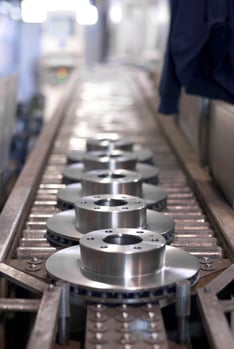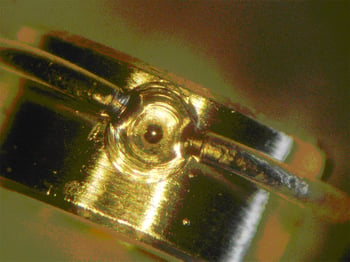 Electronics. Aerospace. Automotive. Medical devices.. All these industries may seem dissimilar, but when it comes to the requirements of manufacturing, they’re all pretty similar. These industries are all dealing with sensitive components required to perform consistently. However, across these industries, parts also need to be trackable and marked by the manufacturing. This is where it can get tricky.
Electronics. Aerospace. Automotive. Medical devices.. All these industries may seem dissimilar, but when it comes to the requirements of manufacturing, they’re all pretty similar. These industries are all dealing with sensitive components required to perform consistently. However, across these industries, parts also need to be trackable and marked by the manufacturing. This is where it can get tricky.
How can you reliably and safely mark these products to meet regulatory requirements regarding tracing and maintain the integrity of a sensitive component? Any traditional method of marking risks exposing the part to potentially dangerous procedures. That’s where laser marking differentiates itself from any other marking method in use.
Quick Links
- What is Industrial Laser Marking?
- How Does Laser Marking Work?
- Benefits of Laser Marking in Manufacturing
- Top Laser Marking Applications
What is Industrial Laser Marking?
Industrial laser marking uses lasers to permanently etch or engrave marks onto materials, including metal, plastic, ceramic and glass. This form of marking is often used in the manufacturing process to create permanent labels, serial numbers, logo markings or other identifying marks on products. The marks created by laser marking are usually highly durable and resistant to environmental factors such as heat, water and even certain acids.
How Does Laser Marking Work?
Laser marking works relies upon a laser beam to rapidly heat up an area of the material surface to temperatures over 1000°C (1832°F), creating a tiny dot or line during the melting process that allows the user to create the desired mark.
Depending on the surface materials and application, different types of lasers are used. More specifically, CO2 lasers are suitable for plastics and wood, while YAG and fiber lasers are better suited for metals like aluminum and steel.
Additionally, the power of the laser determines the depth of the marking; lower power lasers create shallow markings that may, eventually, wear away while higher power lasers create more permanent and durable markings. Further, depending on the material being marked, different types of lasers may be used, such as CO2 for organic materials or YAG for metals.
However, it’s not just about the laser itself. As some applications require precision and accuracy, the software used to control the laser is crucial. Software can help control speed and frequency, assisting in the creation of intricate designs, like logos.
Benefits of Laser Marking in Manufacturing
No longer satisfied with simple alphanumerics, industrial engineers are demanding complex images and machine readable codes that are precise. For many industries, one of the first benefits is that it’s a cost effective solution. In fact, when it comes to identifying medical devices, aerospace components, electronic devices, and many other applications, laser marking has proven invaluable.
Other advantages of laser marking, when compared to other methods, include:
- Speed -many thousand parts per hour
- Accuracy - < 0.01 mm marks
- Consistency- even with speed and accuracy, produce the same mark every time
- Flexibility - can be automated with low maintenance costs and used on a variety of surfaces/materials
- Durability- lasts far longer than other methods
- Temperature/Chemical resistant- resists the high temperatures and harsh sterilization procedures of autoclaving
- Sustainability- as bio-compatible as the device’s base material but involves no solvents, inks, or acids.
- Limits surface degradation and mechanical stress- non-contact so it won’t cause any mechanical stress or distortion in thin parts and parameters
- Cost-efficient- there are no consumables used during the process, no loss, limited waste
- High quality- text, logos and machine readable codes can be made detailed, sharp and clear with resolutions equal to the best 600 dpi black and white ink printer
In summary, industrial laser marking offers many benefits over traditional methods – higher speed, accuracy and reliability combined with reduced costs and less environmental impact make it an attractive option for many manufacturers working with sophisticated components.
Top Laser Marking Applications
As noted above, laser marking is used in a variety of industrial applications, most of which require some of the benefits noted above due to the nature of the industry. While vastly different in nature, several industrial applications require durability, consistency, and accuracy all while maintaining the integrity of the product. There are some specific laser marking applications we’d like to highlight.
 Laser Marking and Medical Device Manufacturers
Laser Marking and Medical Device Manufacturers
Because medical devices are so specialized, the manufacturing FDA and ISO qualification procedures can be rigorous and dedicated. Outlining the advantages and the possible applications is critical when determining how to decrease the cost of marking body implantable components and medical devices while still retaining impeccably high standards. As regulations change and requirements become more stringent, the flexibility and versatility of laser marking will help make the modifications and the retooling effortless.
Laser Marking and the Aerospace Industry
Much like the firearms industry, the aerospace industry, due to technical requirements and the need to track issues, requires all parts to be marked to identify components. This may include serial codes, bar codes, part numbers, codes, and other manufacturing data. .jpeg?width=234&height=350&name=aerospace%20(4).jpeg)
In aerospace, it’s vital that methods of marking parts do not interfere with component performance. Much like the medical industry, the maintenance, repair, and overhaul (MRO) process exposes parts and components to high levels of heat and ensuring the durability of tracking information is essential.
Laser Marking and the Electronics Industry
As anyone who’s worked with technology can attest, electronics and computer components are highly sensitive to everything from elements like heat to even the smallest contact with a foreign object. Still, much like other sensitive components, finding a way to mark electronic components with the necessary tracking marks and manufacturing information requires a system that’s capable of remarkable precision while limiting exposure to potentially damaging marking techniques. Laser marking is, for that reason, the primary marking technique used in the manufacturing of electronic components.
While not exhaustive, this does hint at the commonalities and requirements across industries that are met by laser marking systems. It’s important to find not just the equipment that will meet these needs, but also a supplier that offers software to support your goals and simplify the process.
Further, you want a laser systems partner who knows the laser marking industry and has familiarity with its application in your industry as well. You want more than sales, you want support, training, and service. If investing in a laser marking solution for your manufacturing business is something you’re investigating, get in touch with the LaserStar team today and let’s chat.

